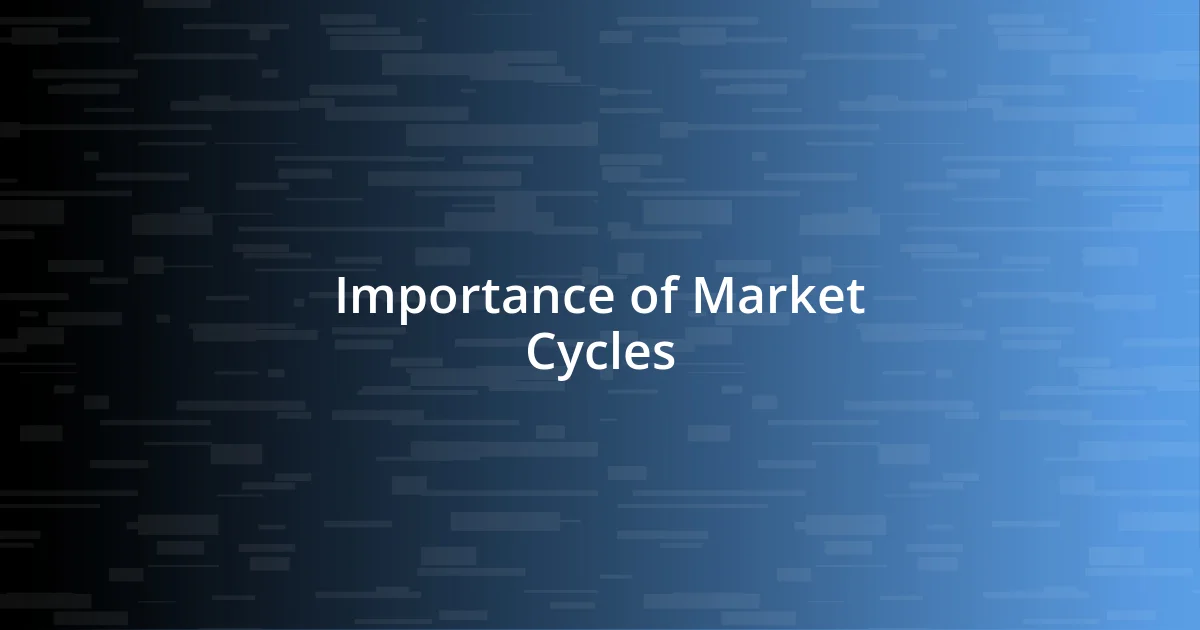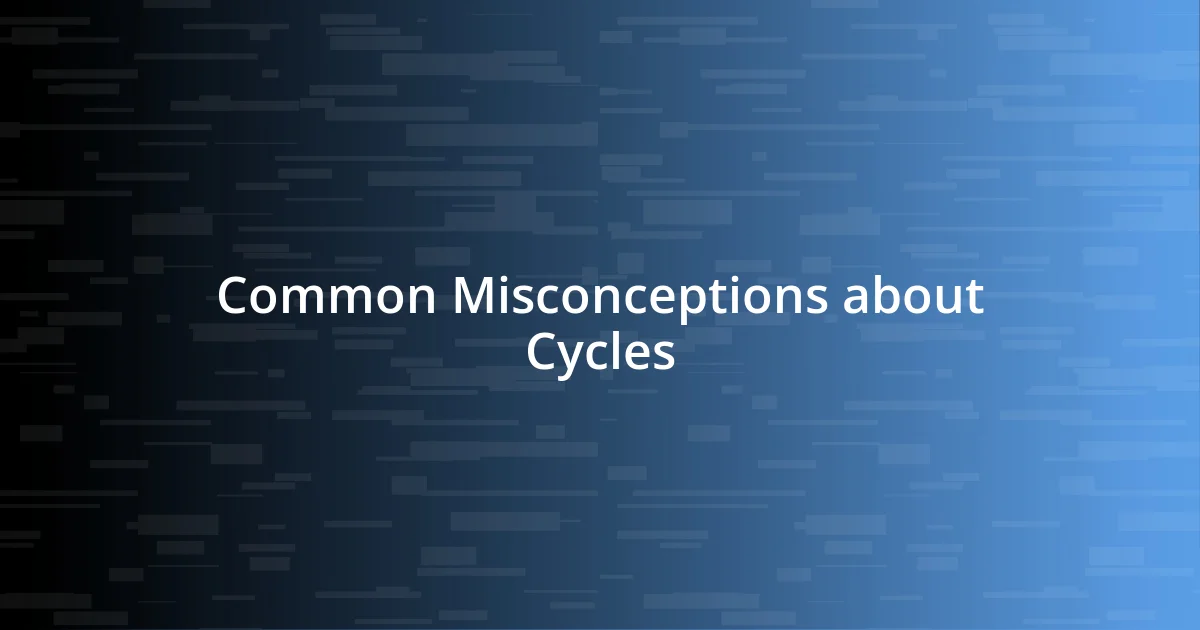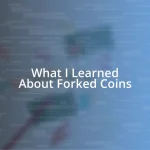Key takeaways:
- Understanding market cycles involves recognizing phases of expansion, peak, contraction, and trough, each reflecting investor emotions and requiring strategic responses.
- Effective investment strategies vary by cycle: focus on growth during expansion, emphasize capital preservation at peak, and seek bargains during contraction.
- Patience, adaptability, and emotional intelligence are crucial for successful investing, allowing one to navigate market fluctuations thoughtfully rather than reactively.

Understanding Market Cycles
Market cycles, at their core, reflect the ebb and flow of economic sentiment. I still recall my initial foray into investing; I was captivated by the idea of timing the market. It wasn’t until I faced a downturn that I realized the importance of understanding the broader cycle — why prices rise and fall.
Have you ever felt the thrill of a market in full swing? I remember celebrating the highs, but then came the sobering moment when reality set in. The linked phases of expansion, peak, contraction, and trough aren’t just technical terms; they represent emotions we all experience. Grappling with the emotional rollercoaster during these phases taught me about resilience and patience.
Understanding market cycles isn’t just about financial metrics; it’s also about anticipating human behavior. For example, during a bullish phase, it’s easy to feel invincible, but that overconfidence can lead to poor decisions. I learned to stay grounded, reflecting on how emotions can cloud judgment, especially when everyone around you seems to be thriving. How do you personally navigate those emotional highs and lows?

Importance of Market Cycles
Market cycles are crucial for understanding the shifting landscapes of investments and the economy. I remember during my early days of trading, I’d get overly excited about upward trends. However, experiencing a sudden downturn opened my eyes, revealing just how vital it is to recognize these cycles. They aren’t just numbers on a graph; they’re reflections of collective investor sentiment, driven by emotions and external events.
The cyclical nature of the market also serves as a reminder of the importance of strategy. During winter months of market contraction, I learned the value of defensive investments. Finding safety in diversified assets helped me weather the storm. This phase taught me that a sound strategy can make a substantial difference, especially when everyone else is caught up in panic sales.
In essence, market cycles not only offer timing insights but also underscore the need for emotional intelligence. I’ve noticed that those who thrive in the market seem to possess a unique ability to detach from the noise. How can we cultivate this detachment to make better decisions? Reflecting on my own experience, balancing awareness of cyclical trends with controlled emotional responses has allowed me to navigate the markets much more effectively.
| Market Phase | Investor Sentiment |
|---|---|
| Expansion | Optimism |
| Peak | Overconfidence |
| Contraction | Panic |
| Trough | Despair |

Phases of Market Cycles
Understanding the phases of market cycles helps me grasp the rhythm of the investments I make. Each phase is not just a marker on a chart; they evoke a visceral response I can relate to. Think about the last time you felt the exhilaration during expansion and the subsequent sinking feeling of contraction. Personally, I remember a time when I was riding the wave of a bullish market, ironically feeling almost invincible. It was like walking on air until the moment came when the rug was pulled out from under me, leading to a sobering realization of just how quickly things can change.
Here’s a breakdown of the key phases:
- Expansion: A period characterized by rising prices, often filled with optimism that everything will continue to improve.
- Peak: At this juncture, emotions can run high, and overconfidence can overshadow logic, leading to risky decisions.
- Contraction: Panic sets in as prices start to fall; it’s where I learned the most about my own resilience and the necessity of having a solid strategy.
- Trough: Feelings of despair dominate, but it’s also a time when opportunities can emerge for thoughtful investors willing to look beyond the fear.
Moving through these phases teaches me a lot about patience and the discipline required in investing. I vividly recall feeling the initial joy of profits only to face the hard lessons that followed. It’s in the trough that I discovered the most about myself: the need to remain calm and remember that the market’s rhythm is part of the journey.

Identifying Market Cycle Trends
Recognizing market cycles can feel like deciphering a constantly changing puzzle. I’ve often found myself reflecting on patterns from past investments to predict future movements. For example, during my first major investing stint, I underestimated the signals of an impending peak. It was the surge in enthusiasm that initially got my attention, but it was only as I observed the volume of speculative trading that I realized how blind optimism can lead to a precarious situation.
The emotional reactions tied to market trends are vital indicators. There have been times when I’ve seen friends ride high on the expansion wave, completely oblivious to the signs of a downturn. Watching this unfold made me appreciate the significance of investor sentiment—optimism can morph into overconfidence so swiftly. How do we cultivate a mindset that keeps us grounded? My approach has been to regularly assess not just market data but also the emotional climate of the investment community. It’s helped me stay alert to shifts in momentum before they become evident on the charts.
While observing market trends, I make it a point to track not just the price movements but also the overall psychology of investors. One instance stands out when, amidst a contraction phase, I noticed a collective sense of despair among traders. Instead of panicking, I leaned into understanding why. That experience taught me that each cycle carries lessons about anticipation and response. Trusting my analysis over my impulsive emotions has allowed me to navigate market turbulence with a clearer head—hasn’t that become the essence of investing?

Strategies for Different Cycles
Strategies can drastically shift depending on the market cycle we’re in. In my experience, during the expansion phase, I focus on growth-oriented investments, carefully researching companies that have strong fundamentals but are not yet widely recognized. This not only allows me to maximize returns but also helps cushion the impact of any potential downturns later on. I remember discovering an emerging tech company in the early stages of a market upswing—investing in it felt like planting a seed that could flourish into a sturdy tree over time.
As for the peak phase, this is when I’ve learned the importance of capital preservation. It’s a time to take some profits off the table and possibly shift into more defensive positions. I once got swept up in the excitement, only to later realize that my overly aggressive stance led to missed opportunities to safeguard my investments. That lesson hit hard. Now, I continuously assess my portfolio to ensure I’m not just riding the wave but also preparing for any unexpected surges in volatility.
During periods of contraction, my strategy pivots towards seeking bargains. I’ve often found strength in the motto, “buy low, sell high.” I vividly recall a time when I picked up undervalued stocks during a market dip that others were afraid to touch. That boldness not only yielded great returns when the market rebounded, but it also instilled a level of confidence in my investing approach. It poses the question—how can we turn fear into opportunity? By adopting a mindset that sees downturns as buying opportunities, I’ve fostered resilience and an optimistic outlook even when surrounding sentiment shifts.

Common Misconceptions about Cycles
There’s a common misconception that market cycles follow a predictable, steady rhythm. In my experience, they are far from linear. I recall a time when I assumed a market dip would follow historical patterns and rebound quickly, but instead, it lingered longer than expected. This taught me that the market can be rather capricious, defying expectations and highlighting that cycles are influenced by many unpredictable factors, including geopolitical events and shifts in consumer behavior.
Another misunderstanding is that a cycle’s peak is the best time to invest. When I first encountered this idea, I found myself getting caught up in the buzz, convinced that momentum would continue indefinitely. Yet, I learned that many successful investors choose to exit positions before the peak, capitalizing on profits rather than getting swept away by euphoria. Hasn’t it become clear that sometimes, selling can be more beneficial than buying, especially when surrounded by a buzz of excitement?
Lastly, the notion that downturns only bring pain can skew our perspective. I remember feeling disheartened during a market slump, but it was during this time that I stumbled upon opportunities that would eventually define my portfolio. Seeing downturns as windows for potential rather than mere loss can reshape our investment approach. How can we shift our mindset to welcome volatility? Embracing that question has often led me to discover undervalued gems that serve as the foundation for my investment strategies.

Lessons Learned from Past Cycles
Reflecting on past market cycles, I’ve come to appreciate the vital role of patience. I remember a time during a booming market when I was eager to jump into every exciting trend I encountered. The thrill of potential profits nearly overwhelmed any caution I should have exercised. That experience taught me the value of waiting for the right opportunity, reinforcing my belief that timing can often be more significant than simply pursuing what’s popular.
Another lesson that stands out is the importance of staying informed and adaptable. I once clung too tightly to a particular investment strategy during a cycle shift, only to watch as it backfired. The forced realization that being flexible and responsive to changing market conditions is crucial in investing has been instrumental. I often ask myself now—how can I tailor my approach to fit the current landscape? It’s a question that keeps me engaged and aware, helping my investing instinct grow sharper with each cycle’s lessons.
Lastly, I’ve learned to balance emotional responses with rational analysis. Early in my investing journey, I allowed fear to cloud my judgment during downturns. I vividly recall selling a solid investment purely out of panic, only to watch it rebound shortly after. It was a bitter pill to swallow, but that experience taught me to step back, breathe, and weigh the facts before acting on emotion. How can we cultivate a mindset that prioritizes thoughtful decision-making? Embracing this mentality has not only improved my investment outcomes but also helped me approach market fluctuations with a level-headed perspective.














